Continued monsoon rains have led to multiple landslides in western Nepal and has affected transport on several of the country’s major arteries. The Sudurpaschim Province has been greatly affected with portions of the East-West Highway and Mahakali Highway being covered with debris flows and mudslides.
Local authorities say that a huge landslide has occurred at Attariya and the East-West Highway has been blocked, hundreds of vehicles and passengers are trapped. Fire fighters and other rescue team are on the scene attempting to clear the road but according to the authorities it may take up to 3 days before the road is clear for use. There are also reports that the landslide has affected power lines thus making it difficult for some of the affected communities to access electricity.
At several places the Mahakali Highway that connects Nepal to India has been blocked by a chain of minor landslides. Boarders have been closed for some time now thus affecting the cross border activities including trading and migration. The Nepal Army has been mobilized to help in the rescue operations and to remove the debris off the roads.
The disruptions are leading to large economic consequences, including the inability to deliver fuel, food and other necessities to many locations. Stocks on the shelves have reduced and this has led to the increase of prices of basic goods in the affected districts. Local authorities are calling on people to stay indoors and save on essentials until the roads are passable again.
The forecast is that there will be more heavy rainfall in the next few days and this will result to more landslides and flooding. The Department of Hydrology and Meteorology has put out warnings for several of the major river system in the area.
The landslides have also affected several under construction hydropower projects in the area as well. Construction has been stopped in several places because of accessibility questions and security problems. This is likely to add more years to Nepal’s attempts to increase the generation of electricity within the country.
Landslide experts blame deforestation and unplanned road construction in the vulnerable Himalayan slopes for the elevation of the risks. They are now demanding better practices of sustainable development and better preparedness to the disasters.
This is especially so since the full extent of the damage is only gradually emerging and the government is now being accused of inadequate investment in infrastructure in landslide-prone regions. Political parties are calling for investigation of the government’s preparedness for disater response.
As the monsoon season is not over yet, officials are concerned that this may be only the beginning of troubles for Nepals roads. It is predicted that climate change will cause more extreme weather conditions in the coming years and this would exert additional pressure on the already weak mountain structures in the country.


